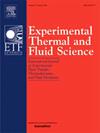基于风洞模型试验的圆角矩形圆柱体气动特性
IF 3.3
2区 工程技术
Q2 ENGINEERING, MECHANICAL
Experimental Thermal and Fluid Science
Pub Date : 2025-07-15
DOI:10.1016/j.expthermflusci.2025.111566
引用次数: 0
摘要
通过刚性模型压力风洞试验和数值模拟,在均匀流场中测量了长径比为2的直角矩形圆柱体和转角半径比(R/D)分别为0.1、0.2、0.3、0.4和0.5的圆角矩形圆柱体的风压。试验雷诺数为1.2 × 105,风向角(α)范围为0°~ 90°。详细分析了风向角和转角半径比对平均阻力/升力系数、波动阻力/升力系数和斯特劳哈尔数等气动参数的影响,并解释了其流动机理。结果表明:在0°风向角下,增大R/D可产生连续分离、分离后再附着和不分离的附着流动。此外,αcr1(较小)和αcr2(较大)两个临界风向角将风向角分为三种类型:较小(0°<;α& lt;αcr1)、中级(αcr1≤α≤αcr2),和大型(αcr2 & lt;α& lt;90°)。这些制度的具体范围因气缸而异。值得注意的是,αcr1随R/D的增加呈现出先降后升的非单调趋势,而αcr2则呈现单调增加趋势。气动参数在小风向角和大风向角工况下的变化比在中等风向角工况下的变化更显著。这些临界风向角表示地表流动状态的转变。这些研究结果为工程应用中圆角矩形结构的抗风设计优化提供了有价值的见解。本文章由计算机程序翻译,如有差异,请以英文原文为准。
Aerodynamic characteristics of rounded-corner rectangular cylinders based on wind tunnel model test
Through rigid model pressure wind tunnel tests and numerical simulations, the wind pressure for a right-angled rectangular cylinder with an aspect ratio of 2, and for rounded-corner rectangular cylinders with corner radius ratios (R/D) of 0.1, 0.2, 0.3, 0.4, and 0.5 was measured in a uniform flow field. The Reynolds number for the tests was 1.2 × 105, and the wind direction angle (α) ranged from 0° to 90°. A detailed analysis examined the effects of wind direction angle and corner radius ratio on the aerodynamic parameters, including the mean drag/lift coefficients, fluctuating drag/lift coefficients and Strouhal number, and the flow mechanism was explained. The results indicate that at 0° wind direction angle, increasing R/D induces three distinct flow patterns: continuous separation, separation followed by reattachment, and attached flow without separation. Furthermore, two critical wind direction angles, αcr1 (smaller) and αcr2 (larger), categorize wind direction angles into three regimes: small (0° < α < αcr1), intermediate (αcr1 ≤ α ≤ αcr2), and large (αcr2 < α < 90°). The specific ranges of these regimes vary with the cylinder. Notably, αcr1 exhibits a non-monotonic trend (first decreasing then increasing) with increasing R/D, whereas αcr2 increases monotonically. Aerodynamic parameters vary more significantly within the small and large wind direction angle regimes than in the intermediate regime. These critical wind direction angles signify transitions in the surface flow state. These findings provide valuable insights for wind-resistant design optimization of rounded-corner rectangular structures in engineering applications.
求助全文
通过发布文献求助,成功后即可免费获取论文全文。
去求助
来源期刊

Experimental Thermal and Fluid Science
工程技术-工程:机械
CiteScore
6.70
自引率
3.10%
发文量
159
审稿时长
34 days
期刊介绍:
Experimental Thermal and Fluid Science provides a forum for research emphasizing experimental work that enhances fundamental understanding of heat transfer, thermodynamics, and fluid mechanics. In addition to the principal areas of research, the journal covers research results in related fields, including combined heat and mass transfer, flows with phase transition, micro- and nano-scale systems, multiphase flow, combustion, radiative transfer, porous media, cryogenics, turbulence, and novel experimental techniques.
 求助内容:
求助内容: 应助结果提醒方式:
应助结果提醒方式:


